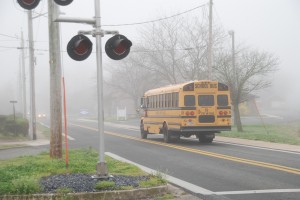
NEWARK — With a continued pattern of thick, early morning fog this week, Worcester County Public Schools were delayed Wednesday and today, but not Tuesday, prompting questions about the process and what factors into the decision.
On Tuesday, thick fog blanketed much of the county in the early morning hours, but Worcester’s public schools reported on time. On Wednesday, similar conditions prevailed and the start of the school day was delayed for two hours. This morning, fog was barely noticeable in north Worcester County, but a two-hour delay was called.
Despite the apparent incongruity, Worcester County Schools Public Relations Coordinator Barb Witherow explained this week there are several factors at play in the decision-making process.
Witherow said Worcester County Public Schools Supervisor of Maintenance, Operations and Pupil Transportation Steve Price makes the call when fog conditions prevail based on a wide variety of factors with student safety being the most important. When the Worcester County area experiences a pattern of early morning fog conditions, which is a common occurrence in the spring because of the cool ocean and bay water temperatures and an influx of warmer air, Price begins the delay decision process around 3:30 to 4 a.m.
Price often checks conditions by driving from one end of the county to the other. He also consults with law enforcement officials and checks weather reports before making a decision. Typically, sometime around 5-5:30 a.m., Price makes a recommendation to Superintendent Dr. Jon Andes, who ultimately makes the call to delay the start of the school day or not.
According to Witherow, the timing of the arrival of foggy conditions is critical in the decision-making process. Because roughly 92 percent of Worcester students ride the bus to school, the timing of the buses starting their early morning runs plays a significant role.
“Some of our buses travel great distances and start their routes very early in the morning,” she said. “Once the buses get rolling and the whole thing is set in motion, it becomes very challenging. If they have made their first stops and picked up students, we wouldn’t have them go back and drop kids back off because that presents another whole set of safety issues.”
Such was the case on Tuesday, when thick fog blanketed much of the area but schools opened at their normal times. Witherow said the timing of the weather event on Tuesday prohibited a fog delay. On Wednesday, however, it became evident much earlier a fog delay was necessary and schools reported two hours late.
“With the volatile spring weather, conditions can change very rapidly around here,” she said. “On Tuesday, the fog dropped in very late and the buses were rolling and the start of the school day was already set in motion. If the buses make even one stop, the decision wouldn’t be reversed. Some parents might have already left for work and we wouldn’t put kids back out on a bus stop.”
Witherow said parents and guardians have options when the school system decides to report on time even if foggy conditions persist.
“If parents are uncomfortable with a decision, or non-decision, they have choices,” she said. “They can decide not to put their kids on the bus and drive them to school themselves, or they can wait until the fog dissipates and conditions improve and bring them to school later.”
However, Witherow emphasized parents and guardians should have complete confidence in the school system’s contracted bus drivers.
“We want to assure parents our bus drivers are highly skilled,” she said. “They go through extensive training in all conditions. Parents and the school system share the exact same goal, and that is student safety. We recognize it can be an inconvenience for parents, but the safety of our students and their children comes first.”
Witherow emphasized student safety takes precedence over all other factors in terms of fog delays with no consideration given to other school activities, such as the MSA tests currently underway.
“Planned school activities, including testing, have no influence on the decision,” she said. “When we assess transporting of students, the only factor we consider is safety.”
Depending on a wide variety of factors, there is often dense fog in the coastal areas of the county, especially Ocean City, while inland areas are clear. Nonetheless, the fog delay decision-making process includes all of the county schools.
“The weather can change very quickly around here and Ocean City can be socked in and it can be sunny just a few miles away in Berlin,” she said. “Nevertheless, it has to be a system-wide decision.”
Witherow said improved technology has made getting the word out about fog delays and other weather delays easier in recent years. Worcester employs an automated school messenger system that reaches out to parents and guardians, the Board of Education’s website is updated in real time and there is also an emergency hotline, in addition to the traditional methods including local television and radio stations.
